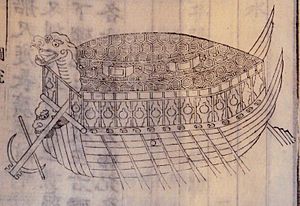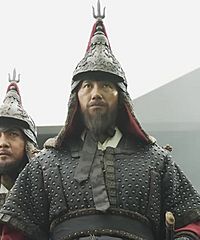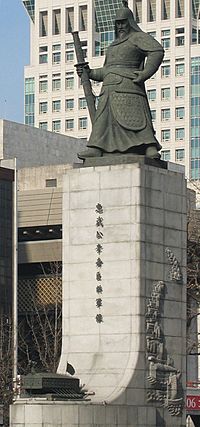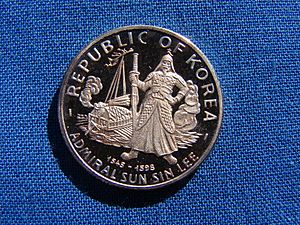Yi Sun-sin facts for kids
Quick facts for kids
Chungmugong
Yi Sun-sin
|
|
|---|---|
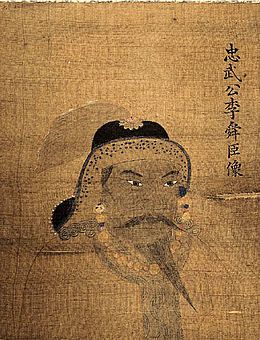
Text reads "忠武公李舜臣像" (Chungmugong Yi Sun-sin Sang; "Portrait of Yi Sun-sin, Lord of Loyal Valor")
|
|
| Born | April 28, 1545 Euljiro-dong, Hanseong, Joseon Korea |
| Died | December 16, 1598 (aged 53) Namhae Island, Gyeongsang Province, Joseon Korea |
| Allegiance | Joseon Korea |
| Battles/wars | Japanese invasions of Korea (1592–98)
|
| Spouse(s) | Lady Bang Lady Oh Lady Buandaek |
| Children |
|
| Birth Name | |
| Hunminjeongeum | |
|---|---|
| Hanja | |
| Revised Romanization | I Sunsin |
| McCune–Reischauer | Yi Sunsin |
| Art name | |
| Hunminjeongeum | |
| Hanja | |
| Revised Romanization | Gigye, Deogam |
| McCune–Reischauer | Kigye, Tŏgam |
| Courtesy name | |
| Hunminjeongeum | |
| Hanja | |
| Revised Romanization | Yeohae |
| McCune–Reischauer | Yŏhae |
| Posthumous name | |
| Hunminjeongeum | |
| Hanja | |
| Revised Romanization | Chungmu |
| McCune–Reischauer | Ch'ungmu |
| Internal Prince Deokpung | |
| Hunminjeongeum | |
| Hanja | |
| Revised Romanization | Deokpung buwongun |
| McCune–Reischauer | Tŏkp'ung puwongun |
Admiral Yi Sun-sin (born April 28, 1545 – died December 16, 1598) was a famous Korean admiral and military leader. He is known for his amazing victories against the Japanese navy. These battles happened during the Imjin War in the Joseon Dynasty.
Admiral Yi fought in at least 23 naval battles. He won every single one, even when his forces were much smaller. He also often lacked enough supplies. His most famous win was the Battle of Myeongnyang. Here, he defeated a Japanese fleet of 333 ships with only 13 of his own. He destroyed or damaged 31 Japanese ships without losing any of his own. Yi died from a gunshot wound at the Battle of Noryang on December 16, 1598. This was the final battle of the Imjin War.
Many people consider Yi to be one of the greatest naval commanders ever. They praise his smart plans, new ideas, and strong leadership. In Korea, he is a national hero. Many places, awards, and movies are named after him. His personal diaries, called Nanjung Ilgi, are even listed as a UNESCO world heritage item.
Contents
- Admiral Yi Sun-sin: Korea's Hero
- Images for kids
- See also
Admiral Yi Sun-sin: Korea's Hero
Early Life and Training
Yi Sun-sin was born in Hanseong, the capital of Joseon Korea. He spent his teenage years in Asan, where his mother's family lived. A shrine to him stands there today.
Even as a young boy, Yi showed great leadership. He played war games with other kids. He even made his own bows and arrows. Later, he became good friends with Ryu Seong-ryong. Ryu was an important scholar who led the military during the Japanese invasions.
In 1576, Yi passed the military exam. He was very good at archery. He broke his leg during the cavalry test but passed after trying again. He then joined the Northern Frontier Army. There, he fought against Jurchen raiders and quickly became known for his skills.
Military Challenges and Rise
In 1583, Yi tricked the Jurchen into battle and defeated them. He even captured their leader. After a break from the army, he led more successful fights against the Jurchen.
However, his success made some of his superiors jealous. They falsely accused him of leaving a battle. Yi was removed from his rank, put in prison, and treated harshly. But after his release, he was allowed to fight as a regular soldier. Soon, he was given new commands.
Yi's hard work in northern Korea paid off. He was quickly promoted four times in late 1590. He finally became the Commander of the Left Jeolla Naval District. He began to make the navy stronger. He also started building the famous turtle ship.
Fighting the Japanese Invasion (1592–1598)
Admiral Yi is famous for his many victories against Japan. These battles took place during the Japanese invasions of Korea (1592–1598). His most well-known victories are the Battle of Myeongnyang and the Battle of Hansan Island.
In 1592, Toyotomi Hideyoshi of Japan ordered an invasion of Korea. Japan wanted to use Korea as a base to conquer China. After the Japanese attacked Busan, Yi started his naval operations. Even though he had never led a naval battle before, he won the Battle of Okpo, Battle of Sacheon, and many others very quickly. His victories made the Japanese generals worried about the sea.
Hideyoshi knew he needed to control the seas to win the war. He built a huge fleet of 1700 ships. He thought he could defeat the Joseon navy just by having more ships.
Why Yi Was So Successful
Admiral Yi was very successful for several reasons. He prepared for war by checking his soldiers, food, and supplies. He replaced anything that was needed. He also brought back and improved the turtle ship, which was key to his wins.
Yi knew the southern Korean coast very well. He used the sea tides and narrow passages to his advantage in battles. He was also a strong leader. He kept his soldiers' spirits high even when they had little food or supplies. He showed loyalty to his people by treating them with respect.
Korean panokseon ships were stronger than Japanese ships. They had tougher hulls and could carry about 20 cannons. Japanese ships usually had only 4 cannons. Korean cannons were also better in range and power. Admiral Yi was a brilliant naval strategist. The Japanese navy liked to board enemy ships and fight hand-to-hand. Yi avoided this by keeping his distance and using his cannons.
Japanese forces landed at Busan in 1592. They quickly captured ports and marched north. They reached Seoul in just 19 days. The Japanese planned to cross into China and use the seas west of Korea for supplies. But Yi Sun-sin always knew what his enemy was doing.
Yi had not studied naval warfare in military school. Neither he nor his officers had fought a naval battle before.
On June 13, 1592, Admiral Yi and Admiral Yi Eok-gi sailed with 24 Panokseon ships and other smaller vessels. They met Admiral Won Gyun and his ships. Their combined fleet of 91 ships sailed around Geoje Island. Scouting ships found 50 Japanese vessels at Okpo harbor. The Korean fleet surrounded the Japanese ships and destroyed them with cannons. They destroyed 11 more Japanese ships at Jeokjinpo the next day. The Koreans did not lose a single ship.
Second Campaign: Turtle Ship Debut
About three weeks later, Admirals Yi and Won sailed to Sacheon Bay. Admiral Yi now had his newly finished turtle ship. Yi ordered his fleet to pretend to retreat. The Japanese eagerly chased them with 12 ships. Once the Japanese ships were out of the harbor, the Korean navy attacked. The turtle ship led the charge, and they destroyed all 12 Japanese ships. Admiral Yi was shot in the shoulder but survived.
On July 10, 1592, the Korean fleet destroyed 21 Japanese ships at the Battle of Dangpo. On July 13, they destroyed 26 more Japanese warships at the Battle of Danghangpo.
Third Campaign: Battle of Hansan Island
Japan's leader, Toyotomi Hideyoshi, called back three admirals to fight the Korean navy. One of them, Admiral Wakizaka Yasuharu, was eager to attack without waiting for others.
The Korean navy, with 70 ships under Admirals Yi Sun-sin and Yi Eok-gi, was searching for Japanese ships. They wanted to stop Japanese supplies from reaching their ground troops.
On August 13, 1592, the Korean fleet learned that a large Japanese fleet was nearby. The next morning, they saw 82 Japanese ships in the narrow Gyeonnaeryang strait. Because the strait was dangerous, Admiral Yi sent six ships to lure 63 Japanese vessels into the open sea. The Japanese followed.
In the open sea, the Korean fleet surrounded the Japanese ships in a "crane wing" formation. At least three turtle ships led the attack. Korean ships fired many cannonballs. They kept enough distance to stop the Japanese from boarding. The battle ended with a Korean victory. The Japanese lost 59 ships. Admiral Wakizaka escaped. After this defeat, Hideyoshi ordered his forces to stop all naval operations.
Fourth Campaign: Busan Harbor
In September 1592, Yi attacked the Japanese in Busan harbor. He later pulled his forces back because he didn't have ground troops to land.
Results of 1592 Campaigns
Yi won every single battle in 1592, at least 15 of them. His campaigns sank hundreds of Japanese warships and supply ships. Thousands of Japanese soldiers were lost at sea.
In 1593, Admiral Yi was put in charge of all three southern provinces' navies. This made him the "Naval Commander of the Three Provinces."
The Amazing Turtle Ships
One of Yi's greatest achievements was improving the turtle ship (geobukseon). While he didn't invent it, he made an older design much better.
Yi's turtle ships had 11 cannons on each side. They also had two cannons at the front and two at the back. The front of the ship looked like a dragon's head. This dragon head could fire up to four cannons. It also made smoke, which was used to scare the enemy.
The sides of the turtle ship had small holes for arrows, guns, and mortars. The roof was covered with planks and sharp spikes. These spikes stopped enemy soldiers from boarding the ship. Japanese ships were taller, so the spikes made it impossible for them to jump down.
Turtle ships had two masts with large sails. They also had 20 oars, each pulled by two men. This meant they could move well even without wind. Historians still debate if they had two or three decks. But it's clear they separated rowers from fighters. This made them very mobile.
Turtle ships were the most famous part of Yi's fleet. However, he never used more than five in any battle. The Joseon navy used cannons as their main weapon. They avoided hand-to-hand combat, which the Japanese navy was good at. The turtle ship helped Yi use this tactic.
Turtle ships were first used in the Battle of Sacheon (1592). They were used in almost every battle until the Battle of Chilchonryang. In that battle, almost all turtle ships were sunk. They did not appear again until the Battle of Noryang.
Turtle ships were best for leading attacks in narrow areas and around islands. They were not used much in the open sea.
A Japanese Trick and Yi's Punishment
As Yi kept winning, the Japanese leaders became worried. Yi constantly attacked their supply ships. This stopped food, weapons, and soldiers from reaching the Japanese army.
The Japanese knew they had to get rid of Yi. No Japanese ship was safe while he commanded the sea. They used the rivalries within the Korean court to trick them. A Japanese spy named Yoshira convinced a Korean general, Kim Gyeong-seo, that he would spy for Korea.
Yoshira told General Kim that a Japanese general, Katō Kiyomasa, would attack on a certain date. He said Admiral Yi should set an ambush. General Kim agreed and told King Seonjo. King Seonjo, desperate for wins, approved the attack. But when General Kim gave Yi the orders, the admiral refused. He knew the location was full of hidden rocks and very dangerous. Yi also did not trust spies.
When King Seonjo heard of Yi's refusal, Yi's enemies at court quickly pushed for his replacement. They wanted General Won Gyun to take his place. They also said Admiral Yi should be arrested.
So, in 1597, Yi was removed from command. He was arrested and taken to Seoul in chains. He was put in prison and treated harshly. King Seonjo wanted to kill Yi. But Yi's supporters, like Minister Jeong Tak, convinced the king to spare him because of his past service. Prime Minister Yu Seong-ryong, Yi's childhood friend, also helped. Yi was not killed, but he was made a common soldier under General Gwon Yul. This was a great dishonor for a general. But Yi accepted it quietly. Many officers still respected him because they knew he had done nothing wrong.
Korean Defeat and Yi's Return
With Yi removed, Japan attacked Korea again in 1597. They sent 140,000 soldiers on 1,000 ships. China sent soldiers to help Korea. The Korean army, with China's help, stopped the Japanese advance.
At sea, Yi's replacement, General Won Gyun, made a big mistake. He ignored reports from his scouts. He allowed the Japanese to land important supplies without a fight. Then, without good planning, Won Gyun attacked the Japanese with almost the entire Joseon navy. This fleet had 150 warships and 30,000 men, all trained by Admiral Yi.
Won Gyun sailed into dangerous waters. The Japanese ambushed the Joseon fleet in the Battle of Chilchonryang on August 28, 1597. Won Gyun was surprised by a Japanese fleet of 500 to 1,000 ships. The Japanese quickly closed in for hand-to-hand combat. The Joseon ships could not use their cannons well. The Joseon fleet was almost completely destroyed. Only 13 warships survived. Won Gyun and another commander were killed.
The Battle of Chilchonryang was the only naval victory for Japan during the war. When King Seonjo heard about the terrible defeat, he quickly pardoned Admiral Yi. He put Yi back in command of the small remaining Joseon fleet.
The Miracle at Myeongnyang
Admiral Yi found the 13 surviving warships and gathered 200 sailors. His entire fleet was now just 13 ships, with no turtle ships left. King Seonjo thought the navy could not be rebuilt. He ordered Yi to abandon the ships and join the ground forces. But Admiral Yi wrote back, saying, "Your servant still has twelve warships under his command and he is still alive, so the enemy shall never be safe in the West Sea."
The Japanese admirals were confident after their victory at Chilchonryang. They sailed out of Busan with over 300 ships. They wanted to destroy Yi's fleet completely. This would allow them to move supplies freely for their land attack on Hanseong.
Admiral Yi carefully studied the Myeongnyang Strait. In October 1597, he tricked the Japanese fleet into entering it. He sent a fast warship near the Japanese base to lure them out. The Japanese thought it was a scouting ship and chased it. They did not know they were being led into a trap.
Yi chose this location for good reasons. The Myeongnyang Strait had very strong currents, whirlpools, and eddies. Ships could only enter safely a few at a time. The tide changed every three hours, limiting how long the Japanese could attack. The strait was also narrow, so the Japanese could not surround Yi's small fleet. The dark shadows from the hills helped hide the Korean ships. There was also a heavy mist that day, making it hard to see. Yi used these natural conditions to cancel out the Japanese's huge number advantage.
The Japanese fleet of about 333 ships entered the strait in groups. The 13 Joseon warships, hidden by shadows, met them with archers and cannons. The Japanese, who preferred close combat, could not fight well. The unpredictable current caused Japanese ships to crash into each other. This made them easy targets for Korean cannons.
Admiral Yi amazingly defeated a force that outnumbered him more than 25 to 1. About 31 Japanese ships were destroyed or damaged. The Joseon fleet had only about ten casualties and lost no ships. The Japanese admiral Kurushima Michifusa was killed.
Yi's amazing victory at Myeongnyang changed the war. The Japanese ground forces, who were about to invade Hanseong, could not get supplies. They were forced to retreat. Today, this battle is celebrated as one of Yi's greatest wins. It is one of the most impressive naval victories in history, given how outnumbered Yi's fleet was.
Final Battle and Admiral Yi's Death
On December 15, 1598, a large Japanese fleet gathered in Sachon Bay. Their goal was to break through the allied forces' blockade and sail home to Japan. Admiral Yi knew exactly where they were from scout reports.
At this time, the Joseon fleet had 82 panokseon and three turtle ships. They had 8,000 soldiers. The Chinese Ming fleet had six large war junks and 57 smaller galleys. They also had 5,000 Ming soldiers.
The battle began early on December 16, 1598. Like Yi's past battles, the Japanese could not fight effectively against the Korean tactics. The narrow Noryang Strait stopped them from moving sideways. Yi's plans prevented the Japanese from boarding his ships, which was their main tactic.
As the Japanese retreated, Admiral Yi ordered his ships to chase them. During this chase, a bullet from an enemy ship hit Admiral Yi near his left armpit. He knew the wound was deadly. Fearing his death would cause panic, he said, "The war is at its height – wear my armor and beat my war drums. Do not announce my death." He died moments later.
Only his eldest son, Yi Hoe, and his nephew, Yi Wan, saw him die. They quickly carried his body to his cabin. For the rest of the battle, Yi Wan wore his uncle's armor and kept beating the war drum. This encouraged the chase.
Comrade Chen Lin
During the battle, the Chinese commander Chen Lin and Yi were good friends. They helped each other many times. When Chen Lin called for Admiral Yi to thank him, Yi Wan told him his uncle was dead. It is said that Chen was so shocked he fell to the ground three times, crying. News of Yi's death spread quickly, and both Korean and Chinese sailors cried in sadness.
Chen Lin later told the Chinese emperor about Yi's death. The emperor honored both Chen and Yi. Yi and Chen are remembered as heroes in Korea. Chen's family later moved to Korea because of his help in defeating the Japanese and his friendship with Yi Sun-sin.
Admiral Yi's body was taken back to his hometown in Asan. He was buried next to his father. Shrines were built all over the land to honor him.
Legacy and Honors
Military Evaluation
Many people see Admiral Yi as a great example of leadership. Military historians like Joseph Cummins and George Alexander Ballard compare Yi to Admiral Horatio Nelson. They say he is one of the greatest naval commanders in history.
Admiral George Alexander Ballard of the British Royal Navy compared Yi to Lord Nelson. Even Japanese Admiral Togo, a hero in Japan, believed Admiral Yi was his superior.
Joseon Government's Reaction
Admiral Yi won many battles. He also protected his soldiers and their families. The people of Joseon trusted him deeply. They saw him as more than just an admiral.
However, King Seonjo and his government were often jealous. They saw Yi's victories and popularity as a threat. They sometimes tried to turn the king against him. Yi was arrested and treated harshly more than once. But his loyal friend, Prime Minister Yu Seong-ryong, helped save him from execution twice. These plots sometimes stopped Yi from getting the men and supplies he needed to completely defeat the Japanese.
Records show that King Seonjo showed no sadness when he heard of Yi's death. Most of Yi's awards were given to him after he died.
Cultural Depictions
Yi's life has been shown in many films and TV shows.
- Seong-ung Yi Sun-sin (1962, 1971) were two movies about him.
- Heaven's Soldiers (2005) showed a young Yi fighting Jurchen tribes.
- Immortal Admiral Yi Sun-sin (2004–2005) was a popular TV drama. It showed his life and battles.
- Director Kim Han-min made a film trilogy about Yi's battles.
- The Admiral: Roaring Currents (2014) was about the Battle of Myeongnyang. It became the most-watched film in South Korean history.
- Hansan: Rising Dragon (2022) is about the Battle of Hansan Island.
- Noryang will show the Battle of Noryang.
Actors who have played Yi Sun-sin include:
- Park Joong-hoon (2005 film Heaven's Soldiers)
- Kim Myung-min (2004–2005 TV series Immortal Admiral Yi Sun-sin)
- Yoo Dong-geun (2013 TV series Gu Family Book)
- Choi Min-sik (2014 film The Admiral: Roaring Currents)
- Park Hae-il (2022 film Hansan: Rising Dragon)
Yi has also inspired books and comics.
- Song of the Sword (2001) by Kim Hoon is a novel from Yi's point of view.
- Yi Soon Shin is a graphic novel series.
He is also a character in video games like Mobile Legends: Bang Bang and Age of Empires II: The Conquerors.
Awards and Memorials
Even though his successes were sometimes ignored during his life, Yi received many honors after his death. He was given the title Chungmugong (Duke of Loyalty and Warfare). This is South Korea's third highest military honor today. He was also made a "First-class military order of merit."
Large statues of Admiral Yi stand in Sejongno in central Seoul and at Busan Tower in Busan. The city of Chungmu, now called Tongyeong, is named after his title. A street in downtown Seoul is also named after him. The Yi Sun-sin Bridge, one of Korea's longest suspension bridges, opened in 2012.
South Korea's KDX-II naval destroyer class and its first ship are named Chungmugong Yi Sun-sin. A Taekwondo pattern is also named after him. His image is on the front of the 100 South Korean won coin.
Images for kids
See also
 In Spanish: Yi Sun-sin para niños
In Spanish: Yi Sun-sin para niños
- History of Korea
- Naval history of Korea
- Turtle ship
- Immortal Admiral Yi Sun-sin
- Nanjung ilgi, War Diary of Admiral Yi Sun-sin
- Joseon dynasty
- Chen Lin (Yi's fellow ally and comrade who fought alongside and brought news of his battles and death to China)


